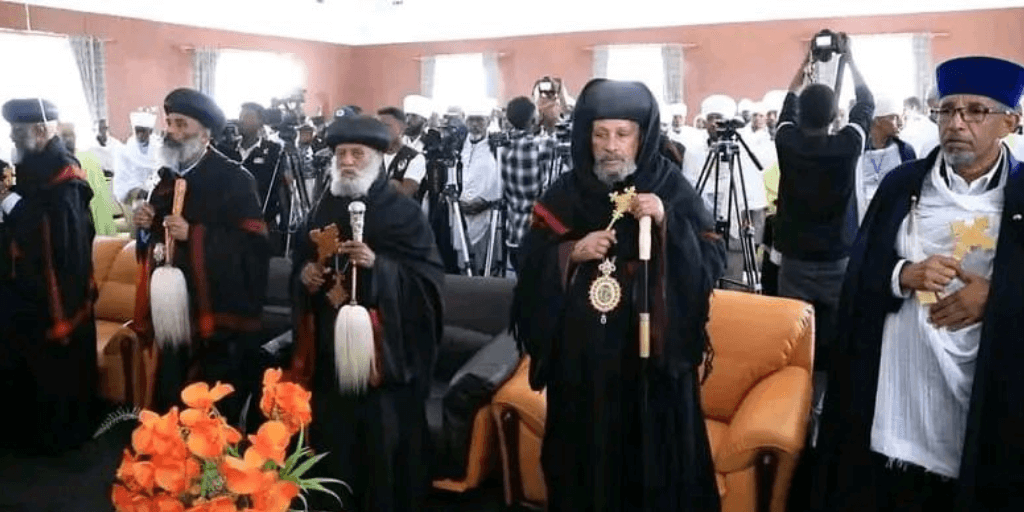How the war in Tigray threatens to split ancient Ethiopian Orthodox Church
By Mihret G/kristos @MercyG_kirstos
Addis Abeba – The Tigray war, which later spilled over to the neighboring Amhara and Afar regions, has resulted in the loss of countless lives, the destruction of historical churches, artifacts, and manuscripts, as well as the shelling of significant landmarks, including Debre Damo. Debre Damo, built in the 6th century by Abuna Aregawi, one of the revered Nine Saints, is one of Ethiopia’s renowned historical landmarks. It sits atop a steep-sided amba, or flat-topped mountain.
During the war in the Tigray region, numerous old monasteries and church sites, including Debre Damo, were destroyed. The abbot of Debre Damo Monastery, Aba Gebretsadikan Areya, claims that Eritrean forces bombed the monastery on 11 January, 2021, using heavy weapons from an area called Siro near Gerhu Sirnay. The artillery strike destroyed twelve monk shelters on top of the mountain, resulting in the death of one monk. The monastery itself has 28 cannon emplacements.
Aba Gebretsadikan told Addis Standard that troops repeatedly shelled Debre Damo in October 2022, striking it eleven times over two continuous days. “The monastery’s top area was targeted seven times, while the guest houses at the bottom were hit five times.” This onslaught caused severe damage, including the injury of a monk, the destruction of over ten guest houses, and the deaths of monastery-owned cows. Aba Gebretsadikan emphasizes that the monastery lacks the necessary funds for restoration and is also facing food scarcity, appealing for urgent humanitarian aid to support the monks living there.
In another atrocity, an anonymous witness, for security reasons, told Addis Standard that his older brother, a farmer and father of nine children, was killed by Eritrean soldiers on 17 July, 2022, while seeking shelter at Ura Cherkos Church in the Gulomakeda Woreda of the Tigray region. The witness revealed that seventeen civilians, including a priest and a deacon, were also killed by Eritrean forces. The church was desecrated, and the victims’ bodies were left unburied, causing an unbearable stench in the area.
The harrowing massacre by Eritrean forces at the Maryam Dengelat Orthodox Church in Eastern Tigray and the massacre of hundreds in the holy city of Axum including in the Saint Mary of Zion church were among other widely reported atrocities committed during the war that targeted Orthodox churches in the Tigray region.
Despite well documented reports from rights organizations, including by the Ethiopian Human Rights Commission (EHRC), the Synod has failed to denounce the massacre. It had also distanced itself from a remark by His Holiness Abune Mathias I, Patriarch of the Church, who described the massacre in Axum as “people left over the ground like leaves.”
Megabi Brhanat Tesfay Hadera, the chief secretary for the newly established See of Selama Kessate Berhan Archdiocese of the Tigray Orthodox Tewahedo Church, explains the magnitude of the atrocities committed against followers of the Orthodox Tewahedo Church in Tigray during the two-year-long war. Numerous churches and monasteries were demolished, including Debre Damo and Amanuel Maeuga Church in Wukro, located 47 kilometers from the regional capital, Mekelle. Al Nejashi Mosque also suffered damages. Witnesses claim that chemicals, including white phosphorus, were used to destroy these religious sites.
The chief secretary also states that priests, deacons, and monks in Tigray were targeted and killed inside churches. Churches, which should have provided sanctuaries for non-combatants, were turned into places of violence, with nuns, girls, and women being sexually violated. Megabi Brhanat Tesfay describes these acts as extreme cruelty that violates both religious laws and regulations. Additionally, churches in Tigray were used as hiding places for weapons instead of sanctuaries for civilians.
Even more distressing, many Ethiopian relics, including manuscripts and bibles, have fallen victim to looting and illegal sales. Reports emerged in early 2022 that these centuries-old artifacts were being advertised for sale on online platforms. There are suspicions that they were plundered from churches during the conflict in Tigray.
Turmoil within the Ethiopian Orthodox Tewahedo Church
Religious leaders in Tigray stressed that while followers of the Orthodox Tewahdo Church in Tigray suffered and churches were destroyed, the Holy Synod of the Ethiopian Orthodox Tewahdo Church (EOTC) in Addis Abeba chose to remain silent. They further accused Archbishops of the EOTC of endorsing the war and disseminating inflammatory rhetoric against the Tigray people during the war.
On 07 May, 2021, the archbishops in Tigray went on and officially announced the formation of the new Tigray Orthodox Church, effectively cutting ties with the EOTC Holy Synod in Addis Abeba. This decision was in response to the perceived silence of the Synod while priests were killed, monasteries and churches in Tigray were destroyed, and religious heritage was looted during the war.

The Holy Synod in Addis Abeba, however, stated that the move by the religious leaders in Tigray violated the institutional unity and existing structural organization of the church. In July 2023, the EOTC was asked to condemn the inflammatory rhetoric from its monks, priests, and deacons and correct their mistakes according to the church’s canon. Failure to do so would result in the Tigray Church severing its relationship with the EOTC, according to the Council of Bishops. However, these efforts proved futile, as mentioned by Megabi Brhanat Tesfay.
Two weeks ago, the Holy Synod of the EOTC issued an official apology for its failure to support the Tigray Region Orthodox Church and its followers during the war. The apology acknowledged the synod’s failure in various aspects, including its absence in Tigray and its inability to provide humanitarian aid. However, it was not enough to ease the growing tension between the EOTC and Tigray religious leaders since the start of the war.
Megabi Brhanat Tesfay criticized the EOTC’s apology, stating that it did not accurately reflect the true extent of the atrocities and crimes committed against the people of Tigray and the followers of the religion. According to him, the apology failed to address the synod’s participation in the war and its support for the federal government, making it unacceptable to the Tigray Orthodox Church.
His Eminence Abune Abraham, the archbishop of Bahir Dar and head of the patriarchate office, refuted similar assertion during a press conference on 20 June, 2023. “Both parties are at fault,” he said. “Prior to the conflict’s escalation, we spoke with religious leaders in Tigray about defusing the situation. However, we didn’t receive a positive replay.”
In the days following the formal apology, His Holiness Abune Mathias I, the Patriarch of the EOTC, visited Mekelle, the capital of the Tigray region. However, he was unable to meet with Tigray religious leaders and only had discussions with regional authorities, including the president of the regional interim administration, Getachew Reda. The delegation reportedly did not receive a spiritual welcome or blessing ceremony from the blessed fathers, priests, and Sunday school members in the Tigray region.
Last week, the Tigray Orthodox Church proceeded with the election of ten high-ranking bishops despite objections from the Synod. The ten candidates were elected on July 16 to lead dioceses both in the Tigray region and abroad. On the same day, the Holy Synod held a ceremony to anoint nine bishops who will be assigned to lead various dioceses in the Oromia Regional State, as well as the Southern Nations, Nationalities, and Peoples (SNNP) and Southwest Ethiopia Peoples Regional States. The ceremony was led by His Holiness Abune Mathias I, the Patriarch of the EOTC.
Despite the challenges, Megabi Brhanat Tesfay expressed his respect for His Holiness Abune Mathias I, as the patriarch has been a voice for the voiceless people of Tigray during the war, while others have turned a blind eye.
On 18 July, management members of the Ethiopian orthodox Tewahdo (EOTC) Patriarchate’s Secretariat Office issued eight points resolution warning against the establishment of the See of Selama Kessate Berhan and related activities by the leaders of Tigray Orthodox Tewahdo Church to appoint ten bishops as candidates for episcopates.
In what can be seen as a veiled legal threat against the establishment of the separate structure in the Tigray region, the eighth point of the resolution stated that while exhaustively following peaceful resolutions to implement all the options to the end stands, a legal committee established through the legal services department of the Patriarchate’s Secretariat Office will work to “uphold the rights and interests of the church by following the appropriate legal procedures,” and for it to be presented to the Holy Synod and given instructions.
The Office yet again called for government’s intervention to stop the move by Tigray religious leaders, calling it a violation of the constitution and the church’s canons…”go beyond the church and undermine national unity and sovereignty”, as well as “cause a national crisis”, the federal government and the interim administration of the Tigray region “should pay special attention to the problem and prepare a discussion forum to play their roles”.
With Archbishops of the Tigray Orthodox Church saying in February 2023, that the See of Selama Kesate Berhan has come into existence “with the blood of the Tigray people”, and is “non-negotiable”, and is not “up for sale”, and with their unflinching position ever since, there is no insight to the resolution of the predicament that is threatening to split one of the oldest institutions of the Ethiopian state, the Ethiopian Orthodox Church. AS







